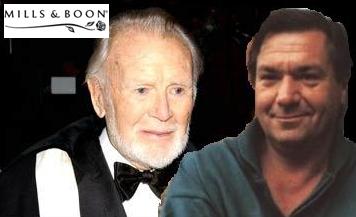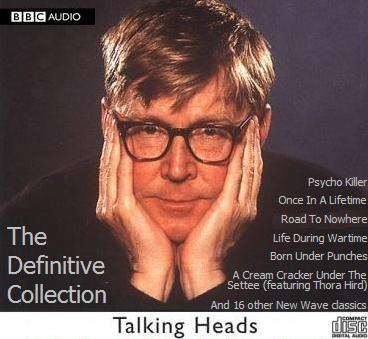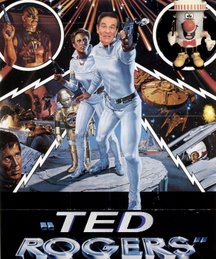Thursday, December 14, 2006
Tuesday, December 05, 2006
Wednesday, November 22, 2006
Bureau des Etrangers, Outlandos d'amour, Jeux Sans Frontières
Jean-Paul Nettles stars as Jersey's favourite big-nosed alcoholic cop, always just failing to arrest the villain thanks to his implausibly large hooter.
Posted by
Paul McQuillan
at
11:40 pm
2
comments
![]()
Monday, November 20, 2006
The Hitman and Her
Coming soon to an Essex nightclub near you . . .
"The Hitman and Her"
Featuring Dennis Waterman, Gordon Strachan and lots of drunk people from Essex.
Posted by
Paul McQuillan
at
8:36 pm
3
comments
![]()
Tuesday, November 14, 2006
Sunday, November 12, 2006
Sunday, November 05, 2006
Thursday, November 02, 2006
Monday, October 30, 2006
"My other car is a talking Austin Maestro"
The Best Cars Ever - Episode II
The Ford Capri
Before becoming American Vice President in 1973, Gerald Ford had only one obsession, stated most clearly in a 1968 speech to the House of Representatives in which he declared,"We must strive, at all costs, to give the working classes of Great Britain an affordable sports coupe."
To this end, Ford approached young actor and stylist Richard Ghia, with a view to creating 'the working man's Ferrari'. The result was unveiled to stunned onlookers at the 1969 Hull Motor Show.

The Capri was a revelation. For little more than the cost of a Hillman Imp, the Great British youth could now afford a car which could easily out-perform Porsches, Lancias and even (sometimes) Vauxhall Vivas. On a 1971 edition of BBC2's Top Gear Lord Lucan achieved a speed of 181 mph in a Capri 3.0i on the M1, going from 0-60 in 4 seconds in a test-start on the hard-shoulder just approaching Loughborough Services (an area later made famous by Gillian Taylforth and Michael Knight).
Throughout the 70s and early 80s the Capri was the car to have for sports-minded Britons, and among its owners were Benny Hill (later a charismatic TV evangelist), Sid James, The Queen Mother and Cardinal Cormack Murphy O'Connor.
Growing up during these years I dearly longed for my dad to get a Capri, and eventually he did, albeit well into the 1980s. It was worth the wait however - it was a Ghia (all top-of-the-range Fords were styled by US actor, Richard Ghia). I vividly recall my dad doing 210mph in our Capri one Sunday morning, on a quiet B-Road. It was nearly as fast as our Austin Maxi had been, and looked so much better. Here's our Capri on our front drive in a photo taken in 1986:

As the pressures of his position as Vice-President (and later President) of America, began to take its toll on Ford, his cars became somewhat less adventurous. The Escort and the Fiesta (named after his two favourite magazines) certainly failed to excite this writer.
Posted by
Paul McQuillan
at
5:52 pm
0
comments
![]()
Monday, October 16, 2006
Ted Rogers in the 25th Century


"Tarmac: That could signify the tarmac on an airport runway, suggesting a holiday. Or it could refer to the tarmac on a road, on which a brand new car would drive. But dustbin vans also drive on tarmac roads . . . . . . "
Meanwhile, in the world of the wireless . . 
This Saturday featuring an exclusive session from Sharon And The Family Stone.
Posted by
Paul McQuillan
at
9:57 pm
1 comments
![]()
Sunday, October 15, 2006
And I, Eeee I, Eeee I, Will Always Love You ooooooooo
Posted by
Paul McQuillan
at
5:04 pm
2
comments
![]()
Saturday, September 30, 2006
Monday, September 25, 2006
My other car's a Lada
Welcome to a new feature on Bloggobbledegook:
The Best Cars - Ever
In which your blogmaster shall present a drive down memory lane, to the days when cars really were cars, and were often manufactured by good, honest British workers, in the five weeks of the year in which they weren't on strike.
Amongst the cars you can expect to see in future installments shall be the Ford Granada, the Ford Capri (the working man's Ferrari) and the Austin Maxi.
I would like to remind my readers that for cheap car insurance visit Endsleigh - Number One for insurance in the UK.
But, let us hasten now to our first trip down the motoring memory-lane:
Austin Allegro
Designed by Labour MP for Grimsby, Austin Mitchell, the Allegro was British Leyland's answer to the ubiquitous Paul Raymond designed Ford Escort. Mark One hit the roads in May 1973 with a quadrilateral steering-wheel designed by Fred Dinenage. 'Allegro', as every music-lover knows, means 'quick' in Italian, and my word was the Allegro quick. It could do 0-60 in 6.2 minutes and had a top-speed of 61mph. A standard late-70s model was the first car my dad got, and I was enthralled that it had a 'sports stripes' sticker along the side. 
Even more exciting was the incredible model owned by my Uncle Trevor however. This was the Allegro 'Vanden Plas' (pictured above), which was a normal Allegro with a radiator grill in the style of a Bentley or similar luxury car.
You simply do not get cars of this class on the roads today.
Fiat 126
It must have been about 1981 and some bloke at the top of our street was eager to flog his wife's 'runaround' (also a children's quiz hosted by Mike Read - "baby, baby, love of my life, Pat, Pat, Pat, baby, listen to me, listen to me"). I was all for it. I had a child's fascination with the Fiat 126 - this midget of a car. This was a car which made the Mini look spacious. The test-drive (on which I was present) however, was not a success. The car started to wobble at any speed above 20mph, and at one point we were overtaken by the paperboy on his Raleigh Grifter. I recall my dad telling the bloke that he would, "have to have a think about it", and the Fiat (which my dad ensured me were all 'rust-buckets' anyway) was not to be ours.
This minuscule automobile was introduced by Fiat in 1972 and had a top-speed of 33mph. Famous owners included Giant Haystacks and Cyril Smith.
Posted by
Paul McQuillan
at
7:54 pm
2
comments
![]()
Thursday, September 21, 2006
"Gamesmaster: I'm stuck on Level 3 of Super Mario Bros"
Today in 1978: Sue Barker absailed down Cliff Richard.
Posted by
Paul McQuillan
at
10:54 pm
0
comments
![]()
Friday, August 18, 2006
"I can hear the sound of Frosties hitting me plate"

New to the Hallmark Channel: 80s classic, TJ Hooker.
William Shatner stars as a tough and cynical ex-cop, forced to go on the game to fund his one-man crusade to rid the streets of crime.
Out now, on Betamax, VHS and Philips V2000 - A cinematic classic.
Posted by
Paul McQuillan
at
6:30 pm
1 comments
![]()
Sunday, August 13, 2006
Wednesday, August 02, 2006
Monday, June 12, 2006
Grape-crushing for beginners.

Today in 1815: The Duke of Wellington deployed 'comedy' duo, Cannon & Ball, at the battle of Waterloo Railway Station, boring the French into submission.
Book News: Andrew Morton to release the truth about an MFI plot to kill Princess Diana, because she was failing to keep up repayments on a self-assembly bedside cabinet.
Posted by
Paul McQuillan
at
5:14 pm
1 comments
![]()
Sunday, June 04, 2006
Never a Crossed Word
Editor's Choice, in this month's Gramophone Magazine:
Soprano diva Ms Copsitck, accompanied by the Berlin Philharmonic Orchestra (conducted by Tom O'Connor), sings a beautiful selection of popular Italian operatic arias, including selections from La Traviata, La Boheme, Tosca and Cavalleria Rusticana. Sandy Toksvig joins her in an emotionally charged performance of the famous Act I love duet from Verdi's Otello.
Sellers like this are a credit to ebay A++++++++++
Posted by
Paul McQuillan
at
9:34 am
2
comments
![]()
Wednesday, May 17, 2006
"One's going to talk so sexy, she'll want one from one's head to one's feet"
Posted by
Paul McQuillan
at
6:36 pm
3
comments
![]()
Saturday, May 13, 2006
Sunday, May 07, 2006
Out of the whirlwind
I apologise to my readers that I have not been able to think of anything amusing for one whole week now. Until I do, may I present a photograph which may be of some interest. I took this at 1am on Friday, in a local nightspot, your Blogmaster enjoying his annual brush with night-life. This is none other than Jimmy White, looking rather seedy, watching ladies on the dancefloor, snapped by me on my mobile phone. Earlier that evening he had been doing an 'exhibition night' at a local snooker club, and actually was right beside me in the toilets at one point. But I was too shy to speak. I just froze! 

Posted by
Paul McQuillan
at
10:52 pm
2
comments
![]()
Sunday, April 30, 2006
Friday, April 28, 2006
Wednesday, April 26, 2006
He's written that perfect.
Extracts from my forthcoming book, The History of Snooker, which will be released by Oxford University Press this autumn.
Antiquity
The origins of snooker are generally agreed to be British, and dating at least as far back as the Iron Age. In the area surrounding Stonehenge, spherical stones, believed to be early snooker balls, have been unearthed by archaeologists, along with what appear to be primitive iron cues and slate-bed tables. Beyond the archaeological evidence, we have no way of knowing what form this primitive form of billiards would have taken, although cave-paintings in the ancient Pictish settlement of Coch' ròd (in modern-day Scotland) show what appears to be a Pict warrior attempting to escape from a tricky full-ball snooker.
Early Middle-Ages
The first written description of our game comes from the Venerable Bede (AD 672-735). In his Lives of the Abbotts of Wearmouth and Jarrow, Bede details a particularly heated controversy between the twin monasteries over the correct interpretation of the miss rule. The conflict was eventually resolved by way of a Papal Bull, issued by Innocent XXIV in 712 AD.
It would appear that the game was very different in those days. Bede makes no mention of either the brown or pink ball, and his description of the playing-table led the great medieval scholar Silvino Francisco to hypothesise that it was a quadrilateral, with four pockets only.
Snooker and The Reformation
Snooker by no means escaped the upheaval of The Reformation. Many of the reformers objected to the ornate style of the contemporary playing equipment (gold cues etc), as well as the elaborate rituals which had come into being. Of particular controversy was the practice of the burning of incense every time a break of over 30 was made, and the announcing of scores in Latin. These perceived abuses were eventually outlawed by Elizabeth I and, despite some disquiet in the north (wooden cues were burnt in Durham Cathedral in protest), the playing of snooker returned to the simpler forms believed to be a truer reflection of the ancient traditions.
Victorian Innovations
The game we now know as snooker can only truly be said to have been established in the late 19th century, when the final break with other billiard forms was made. Various aristocrats in Imperial India codified the modern-day format, the chief architect being Lord Snooker of Beaconsfield, hence the modern name of the game.
Developments in the Early 20th Century
The game continued as the plaything of toffs until gradually also gaining popularity with gangsters in the East-End of London, and later other British cities. Basement snooker-halls became convenient theatres of gangland activity. On a healthier note, the growth in popularity of the game led to the introduction of organised competitions, including the Word Championship. This came to be dominated by Joe Davis (great-grandfather of current player Steve Davis), who won every world championship held between 1902 and 1968. His finest moment was perhaps the 1937 final where, aged 98, he beat the teenage Eddie Charlton 654 frames to 212, in a match which lasted 8 months.
The Television Boom
Just as snooker was seemingly becoming staid in the late 60s, the introduction of colour TV proved to be the catalyst for its re-invigoration. The BBC introduced a one-frame based competition called Pot Black, to show-off its new colour service on BBC2. This led to a great boom. This golden age of the 1970s and early 80s saw the emergence of many charismatic players. One instantly thinks of the Canadian triumvirate of Kirk Stevens, Bill Werbeniuk and Cliff Thorburn. Stevens a white-suit-wearing coke-snorting playboy; Werbeniuk a 35 stone lumberjack, who drank 30 pints of lager before a match, just to 'steady his cue-arm', and the suave mustachioed Thorburn, nicknamed 'The Grinder', on account of his habit of grinding himself against his cue, in a manner which scandalized Mary Whitehouse.
The most successful player to emerge in the early 80s was Steve Davis, the first ginger man to be shown on BBC television before the 9pm watershed. Davis's popularity changed the public's perception of ginger people, and he later became the first ginger man to be awarded an MBE (although some reactionaries were scandalized by this).
Davis was involved in the match which represents the very highpoint of snooker's popularity. The 1985 World Championship Final saw the entire population of the United Kingdom stay up till 4.00am to watch genial goggle-wearing Irishman Dennis Taylor beat Davis in a tense final-ball thriller. Thereafter it has to be admitted that the game has decreased in popularity. One reason for this was the emergence of Scottish teenager Stephen Hendry, a dour young man who nevertheless did not miss a single pot, in a single match, between 1988 and 1996. The new breed of players seemed to lack the individual charisma of the older, although the emergence of former sit-com actor Richard O'Sullivan, in the late 1990s, did provide a certain injection of excitement.
The Future
After deciding that calling a tournament 'The Embassy World Championship' encouraged, nay virtually forced, the great British public to instantly rush to the local Spar, buy 20 Regal Kingsize and take up smoking, the Blair government banned cigarette sponsorship, thus decimating the finances of the game. Whereas Terry Griffiths collected 21 million pounds for winning the 1979 World Championship, this year's winner will collect a paltry 950 pounds. This does not bode well for the future of the game, and nor does the regrettable ban on adverb usage, forced on to snooker commentators by the BBC hierarchy, in a desperate attempt to 'dumb down' and compete with the illiterate output of rival channels. There are some reasons to be cheerful though - the game retains its ability to surprise, such as during this year's championships when Nigel Bond spontaneously combusted during Frame 14 of his second round match with Graeme Dott.
Posted by
Paul McQuillan
at
6:35 pm
2
comments
![]()
Sunday, April 23, 2006
When I grow up, I'd like to work in a call-centre.
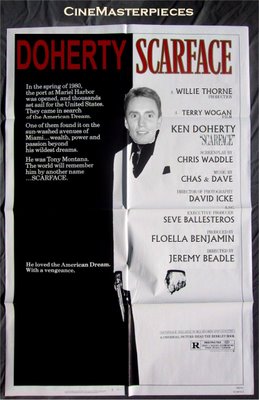
I heard a rumour that next year's London Marathon is to be re-named 'The London Snicker'. Just a rumour at this point . . .
Posted by
Paul McQuillan
at
10:04 pm
1 comments
![]()
Tuesday, April 18, 2006
I met a hula mistress somewhere in Waikiki, Well she was sellin' pineapple, playin' ukulele
Posted by
Paul McQuillan
at
4:43 pm
1 comments
![]()
Thursday, April 13, 2006
Yeah, yeah, yeah
Onstage (until we got told to get off) at a dimly-lit Cavern Club, Liverpool, last Saturday night: The new fab-four, on tour. Your blogmaster is the good-looking one second from the left: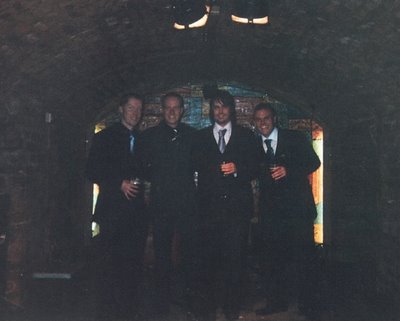
Posted by
Paul McQuillan
at
5:43 pm
6
comments
![]()
Monday, April 10, 2006
Thursday, April 06, 2006
Wednesday, April 05, 2006
Gary Numan - Apologia Pro Vita Sua
Idea for a television programme: Chris Tarrant to host a gameshow based in the Middle East, entitled 'Oman Oman.'
The Blogmaster wishes to announce that he shall be away from Friday till Monday, visiting the home city of Derek Acorah and Tom O'Connor, including attending the Grand National on Saturday, where I hope to hang around anywhere I see a TV camera in the hope of getting 'on the telly'.
Posted by
Paul McQuillan
at
6:52 pm
1 comments
![]()
Sunday, April 02, 2006
Achtung! Neu Rasiermesser von USA!
New from Gillette. The very best shave a man can get.
The all-new Mach 12. Twelve precision, platinum-coated DLT blades, 28 micro-fins, aloe-vera and champagne talking lubrastrip, 18 carat gold handle. Each blade is mounted on a hydraulic suspension system based on Formula 1 racing-car designs and shaves progressively closer than the last, leaving you with a shave which John Craven called, "close". The new talk-o-lubrastrip™ tells you (in 8 languages) when your blades are nearing the end of their life, and also warns you should you press too hard whilst shaving. A 4GB mp3 player keeps this razor ahead of the competition - truly a razor for the 21st century - and beyond!
As used by Bill Oddie, Dave Lee Travis, Rolf Harris and Matthew Corbett
Replacement Blades: £38.99 for a pack of 3
Posted by
Paul McQuillan
at
10:19 pm
1 comments
![]()
Monday, March 27, 2006
Sid James - The Duke of Barbara Windsor
The year is 1982. 18 million people are unemployed and Argentina is threatening to invade the country. It is a cold Monday, October evening, as you relax and press the 'Teletext' button on your new Pye Teletext Television . . . .
Posted by
Paul McQuillan
at
9:52 pm
0
comments
![]()
Ben Johnson - Elizabethan playwright on anabolic steroids
Posted by
Paul McQuillan
at
6:10 pm
1 comments
![]()
Sunday, March 26, 2006
Wednesday, March 22, 2006
Tuesday, March 21, 2006
Saturday, March 18, 2006
Thursday, March 16, 2006
Making the news in 1981

With all due respect to http://weetinyeyes.blogspot.com/2006/03/news-headlines-1983.html
Posted by
Paul McQuillan
at
6:42 pm
0
comments
![]()













